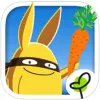Take a look inside 5 images
Gro Garden
Pros: Kids explore and navigate freely.
Cons: Some usability issues and a slow start could prove frustrating for some kids.
Bottom Line: A nice introduction to sustainable gardening and the cycle of plant life.
Use Gro Garden to get kids involved with gardening and sustainable living, with both on- and off-screen activities. Let kids explore the app on their own to discover planting, growing, harvesting, collecting scraps, and making compost. Ask them to describe what they're doing, and use the game as a discussion starter about conservation and health. Why is it important to reuse our food scraps to grow more food? What benefits do we get from eating fresh, nutritious foods? Talk about ecosystems or study the science of plant growth -- what roles do sunlight, water, and compost play in helping vegetables grow? Involve kids in making a real-life garden. Even some potted tomato plants can be enough to give kids the real, full sensory experience of caring for plants and harvesting vegetables. Or, visit a nearby vegetable or fruit farm. Get kids involved in eating the food they grow, or fresh, nutritious, locally grown food. Have them research and report on nutritive properties, look for recipes, cook, and finally, eat!
Kids can visit three areas in the Gro Garden: the garden plot, the house, and the compost bin. Kids plant seeds and then shine the sun's rays and drag rain clouds around to nurture crop growth in the garden plot. When the veggies are ready, kids gather them in a basket and bring them to the house where hungry animals are waiting to eat. Kids feed the animals and gather the food scraps to bring to the compost bin. They can give the scraps to microorganisms in the compost and collect the nutrient-rich soil. And then they can bring that to the garden and use it to help their crops grow faster. Kids earn more seed types, special food treats, and different microorganisms as their garden grows.
Gro Garden is a great, easy way to get kids excited about and engaged in gardening and sustainable living. With each area depending on some action in another area, kids get a sense of how growing and consuming food can be interconnected. They are free to drive their own experience cycling through planting, harvesting, eating, making compost, and planting again.
It would be nice to see more background information, such as the names of the vegetables that kids are growing. Things can also get a bit overwhelming in the garden plot as rain clouds continually roll by, bugs threaten to eat the crops, and vegetables pop up to be harvested. Kids might get more out of the experience if each aspect were a bit more purposefully introduced and kids were allowed time to explore. This virtual garden doesn't fully represent the real thing (there are no consequences for overwatering or failing to harvest full-grown veggies) and offers only a small taste of the rewards. Nonetheless, Gro Garden is a charming introduction to the wonders and excitement of sustainable gardening.












